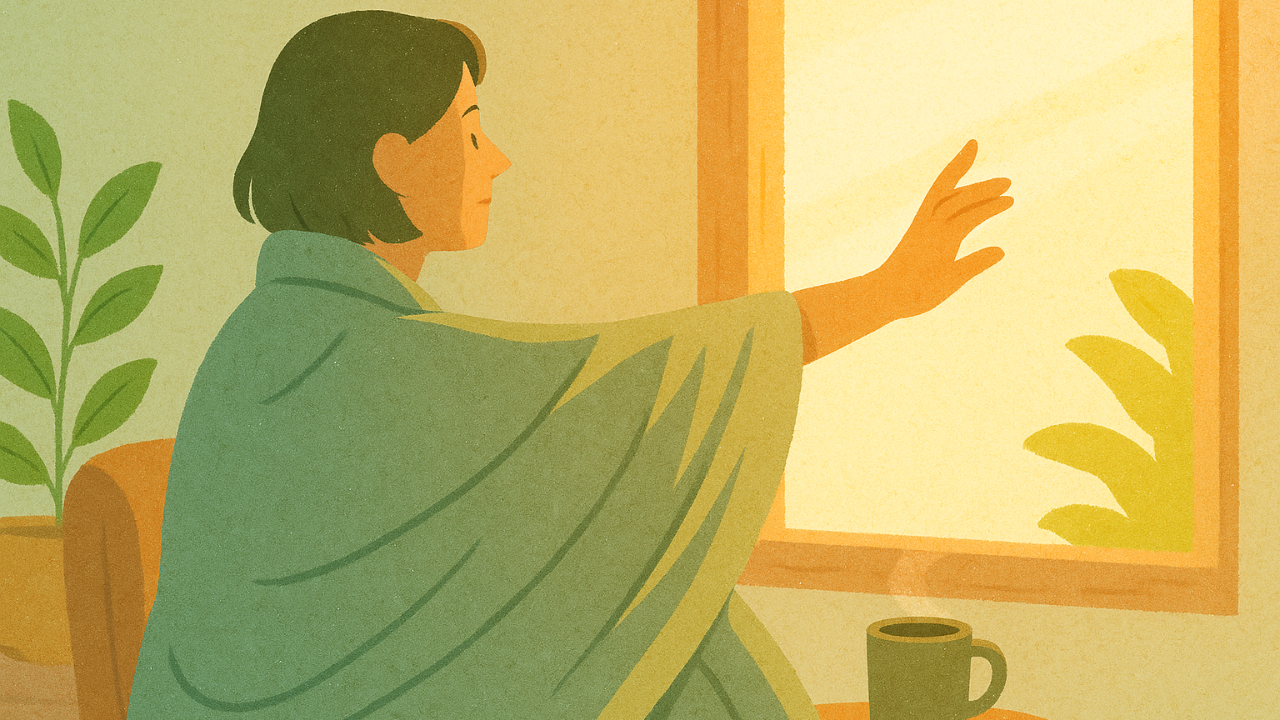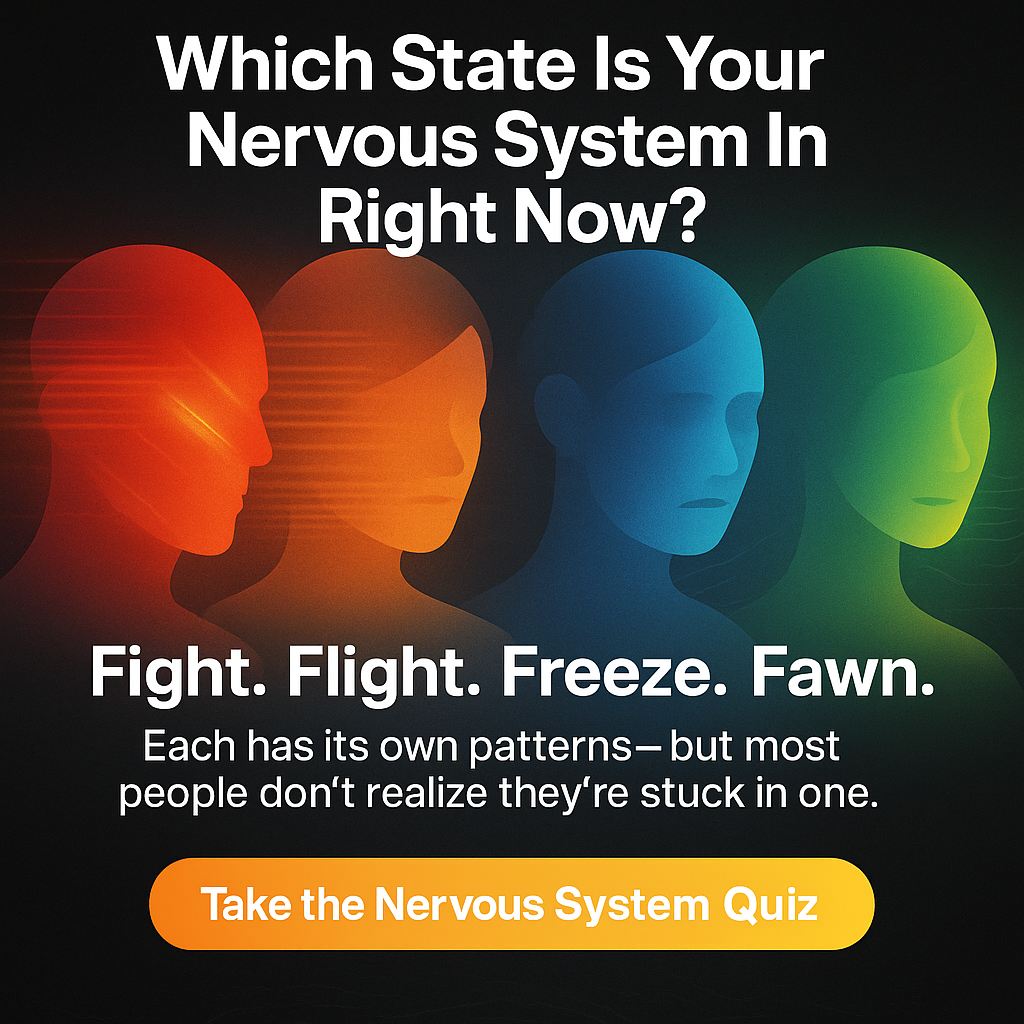
Shutdown Response vs Burnout: How to Tell the Difference
You might feel flat, foggy, or like your body suddenly “turns off.” Other days, it’s more like a deep exhaustion that never seems to lift. Both can feel similar, but there’s an important difference between a shutdown response and burnout.
If your body’s stress patterns confuse you, you’re not alone. You can take the Stress Loop Quiz to see which part of your nervous system might be running the show right now.
What’s the Difference Between Shutdown and Burnout?
A shutdown response is your body’s emergency brake. It happens when your nervous system senses too much at once and decides to protect you by “powering down.”
It’s part of the freeze or collapse state described in Polyvagal Theory.
Burnout, on the other hand, builds slowly over time. It’s what happens when stress, overwork, or caregiving demands keep your system in fight-or-flight for months or years, until your energy reserves are gone.
If this feels familiar, you might also relate to the sense of being “numb yet anxious” described in Why Your Body Goes Numb During Stress.
How a Shutdown Response Feels in the Nervous System
- Sudden drop in motivation or emotion.
- Feeling “numb,” blank, or distant from your own thoughts and feelings.
- Wanting to hide, sleep, or avoid contact.
- Body feels heavy or slowed down, like moving through syrup.
- Speech may become quiet or flat. Thoughts may appear slower.
- Often happens right after a stressful event, emotional overwhelm, or sensory overload.
This is your body moving into the freeze or collapse state of the vagus nerve pathway, a temporary disconnection meant for safety. This state isn’t failure. It’s your body saying, “I can’t do more right now.”
Gentle, body-based tools like pendulation or slow vagus nerve breathing can help remind your system that it’s safe to come back.
How Burnout Feels in the Nervous System
- Constant fatigue, even after rest.
- Feeling detached from work, people, or purpose.
- Brain fog, poor concentration, and low creativity.
- Frequent tension, headaches, or gut issues.
- Emotional numbness, irritability, hopelessness, or cynicism.
- Feels endless and cumulative, not sudden.
Burnout is often the end stage of long-term stress loops. You might find it helpful to explore Building Resilience To Withstand The Storms Of Stress or How to Widen Your Window of Tolerance Daily for gradual recovery ideas.
Quick Way To Tell
Ask yourself:
- Did this come on suddenly after a stressful moment? → Probably a Shutdown.
- Has this built up for months despite rest? → Likely Burnout.
Shutdown is short-term protection. Burnout is long-term depletion.
Gentle Steps That Help
For Shutdown:
- Focus on gentle sensory input to remind your body you are safe
- Warmth, rocking, humming, or feeling your hands or feet on a surface.
- Try a 10-Minute Nervous System Reset to gently wake your system.
For Burnout:
- You'll need consistent restoration over time.
- Schedule consistent micro-rests. Add soft joy—not productivity—into your day. Use hydration and sunlight to rebuild basic regulation. (Hydration for Nervous System Regulation explains why this matters.)
- Light movement, connection, laughter, and deep rest that isn’t just sleep. If your fatigue shows up most after long screen time or meetings, you might like these quick nervous system relief ideas for Zoom fatigue.
If it’s hard to know where to start, the Stress Loop Quiz can give you a snapshot of what kind of support your body needs most.
A Gentle 7-Day Plan
Day 1-2: Notice signs of shutdown vs exhaustion without judgment.
Day 3-4: Add 10-minute rest periods, ideally outdoors or with slow music.
Day 5: Try mild movement like walking or stretching.
Day 6: Do one small thing that brings joy or comfort.
Day 7: Reflect on what helped you feel most alive, not just less tired.
Common Sticking Points
“I don’t feel anything.”
That’s your body still protecting you. Focus on gentle sensory noticing before emotions.
“Rest makes me anxious.”
When fight-or-flight has been running too long, slowing down can feel unsafe. Go gradually: rock, hum, or walk before resting.
“Rest doesn’t help.”
When your body is deeply depleted, it may take structured recovery to feel change. This may include routine, nutrition, boundaries, and co-regulation.
“I keep cycling between overdoing and shutting down.”
That’s common for trauma-shaped systems. You might like the story in Why Do I Always Feel Ready To Jump Out Of My Skin For No Reason?, which explains this pattern beautifully.
“I go numb again after social situations.”
That’s a sign your system is still learning to stay regulated. You can build capacity slowly through grounding, pendulation, or EFT tapping.
More Gentle Reads
- The Gut-Brain Connection and Trauma, Simply Explained
- Grounding During Panic Without Talk Therapy
- Vagus Nerve Massage Techniques For Beginners
FAQs
1. Can shutdown and burnout happen at the same time?
Yes. Many people cycle between both. You might push through long periods of stress (burnout) and then suddenly collapse into numbness or withdrawal (shutdown). The key is noticing the early signs so you can pause before your system crashes.
2. Why do I feel guilty for needing rest?
If you grew up in environments where productivity or perfection was tied to safety or love, rest can feel “wrong.” This isn’t laziness—it’s conditioning. Relearning that rest is safe takes practice, not willpower.
3. How can I tell if I need medical help or just nervous system support?
If your exhaustion or disconnection affects daily functioning, lasts for months, or includes physical symptoms like dizziness, chest pain, or fainting, it’s wise to talk with a qualified professional. You can still use gentle nervous system tools alongside medical support.
4. What helps prevent burnout from coming back?
Boundaries and rhythm. Schedule pauses before your body demands them. Include micro-moments of co-regulation throughout your day: a walk, laughter, sunlight, or slow breathing.
5. Why do I crash after feeling better for a while?
Healing isn’t linear. When you first start to regulate, your system opens just enough to release old tension, which can cause temporary dips. It’s a sign your capacity is growing, not that you’re going backward.
6. Is it normal to feel more emotional when I start resting?
Yes. When your body finally slows down, stored feelings can rise to the surface. It’s part of thawing from chronic stress. Ground yourself through touch, gentle movement, or EFT tapping for calming.
Disclaimer: This article is educational and not medical advice. If you have health concerns, consider speaking with a qualified professional.
Discover Your Vagal Tone
Find out how dysregulated your nervous system is and get your personalized roadmap to feeling calm, energized, and in control


